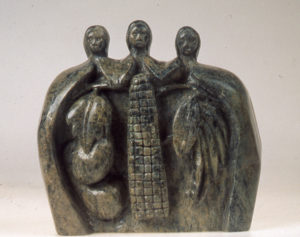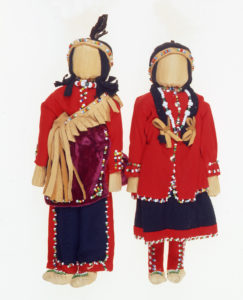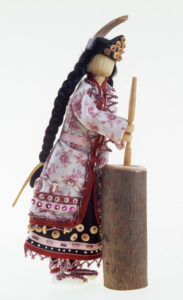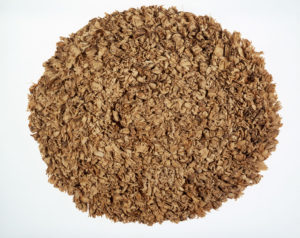To the Iroquois people, corn, beans, and squash are the Three Sisters, the physical and spiritual sustainers of life. These life-supporting plants were given to the people when all three miraculously sprouted from the body of Sky Woman's daughter, granting the gift of agriculture to the Iroquois nations.
The Iroquois agricultural system was based on the hill-planting method. Iroquois women, who were responsible for farming, placed several kernels of corn in a hole. As the small seedlings began to grow, the farmers returned periodically to mound the soil around the young plants, ultimately creating a hill one foot high and two feet wide. The hills were arranged in rows about one step apart.
Iroquois women mixed their crops, using a system called "interplanting." Two or three weeks after the corn was planted, the women returned to plant bean seeds in the same hills. The beans contributed nitrogen to the soil, and the cornstalks served as bean poles. Between the rows, the farmers cultivated a low-growing crop such as squash or pumpkins, the leaves of which shaded the ground, preserving moisture and inhibiting weed growth.

Three Sisters
Gregg M. Thomas (1952- ), Wolf clan, Onondaga, Nedrow, New York, 1996
Serpentine, steatite, varnish?; 36181-1
Iroquois sculptors frequently carve the Three Sisters (corn, beans, and squash), a favorite theme, in stone or antler.
Sister Corn
For centuries, corn was the staple grain of the Americas, and it has sustained generations of Iroquois people. Iroquois women raised several colors and varieties of corn, including flint, flour, pod, pop and sweet.
Every part of the ear of corn was used. Women braided the husks for rope and twine and coiled them into containers and mats. Shredded husks made good kindling and filling for pillows and mattresses. The corncobs served as bottle stoppers, scrubbing brushes, and fuel for smoking meat. Corn silk made hair for cornhusk dolls.
Today corn continues to be an important part of Iroquois life. Many families have small gardens where they cultivate enough white corn for their needs, and some raise surplus corn for ceremonial use. For many Iroquois people, corn remains a sustainer of life.
Corn in the Americas
When Europeans arrived in 1492, fields of corn grew throughout the Americas. Corn had been an agricultural staple for more than 8,000 years and represented one of the most remarkable plant-breeding accomplishments of all time. In the cold regions of Canada and the South American Andean highlands, American Indians developed rapidly maturing varieties. Inca farmers of Peru grew it on the terraced hillsides of the Andes, and Hopi farmers irrigated extensive fields in the dry heat of the Southwest. Corn, in its many varieties, was the foundation upon which the great civilizations of the Americas were built.
Archaeologists believe that corn traveled north from Mesoamerica, where it was first domesticated. The first ears of corn, descended from a wild grass called teosinte, were very tiny. However, over the centuries, the Native peoples of the Americas developed larger varieties of corn that could sustain them.
As varieties of corn adapted to different environments developed, corn spread across the continents, becoming the staple of the majority of American Indian people and transforming life in the Americas.
Cornhusk Dolls
The art of cornhusk doll-making links us to our past, through the corn, as part of the Three sisters, our life staples.
Gail General and Pam Brown, Mohawk, 1990
Iroquois women have a lengthy tradition of creating dolls from cornhusks. In the past, they made the dolls for girls to play with or for use in rituals. Today women also make them for sale to non-Native collectors.
The dolls generally have no facial features. An old story tells that once the cornhusk people had beautiful faces. However, they spent so much time admiring their own reflections in pools of water that they forgot they should be entertaining the children. As a consequence, the Creator turned the cornhusk people into dolls.

Cornhusk Dolls
Iroquois, ca. 1950s
Cornhusk (Zea mays), commercial cotton and wool, glass, Ring-necked Pheasant (Phasianus colchicus) feathers, commercial leather, plastic, male Red-winged Blackbird (Agelaius phoeniceus) feather; female, L 4.3 x W 10.5 x H 25.0 cm; male, L 4.3 x W 12.0 x H 31.5 cm; 34606-12 & 13, gift of Dr. Betty J. Meggers
The Women's World
Women have always had an honored place in Iroquois society, and they possess great responsibility and power. Clan mothers, the leaders of the clan, select the council members, or chiefs, and have veto power over the men's decisions. Women not only manage the political life of the Iroquois people; they are caretakers of the agricultural cycle as well.
The life-supporting Three Sisters were given to the people when all three miraculously sprouted from the body of Sky Woman’s daughter. A woman gave the Three Sisters to the people, and the plants are named for women. It is the women who have always planted, cultivated, harvested and processed the crops.
The planting and the gardening were a privilege. They were connected to the Mother Earth, and the feeling, I was always told, was that you give birth, you plant seeds, and, because you are connected to the Mother Earth, things will grow well, things will grow bountiful, said Audrey Shenandoah, Deer Clan Mother, Onondaga, in 1998.
Women also supplemented their families' diets by collecting a wide array of edible wild plants from the forest. Berries, mushrooms, nuts, milkweed greens, wild onions, and asparagus are just a few of the things that Iroquois cooks mixed with wild game and cultivated foods.

Cornhusk Doll Pounding Corn
Robin Bucktooth, Onondaga, Nedrow, New York, 1993
Cornhusk (Zea mays), commercial cotton, unidentified wood, glass, plastic, unidentified bone, commercial leather, Mourning Dove (Zenaida macroura) feather, unidentified shell; L 15.6 x W 8.4 x H 29.6 cm; 35564-1 a-c
In the past Iroquois women raised several varieties of corn. The first sound heard in the village each morning was women rhythmically pounding corn. They used large oak mortars with long, hardwood pestles. Even though corn required extensive processing, the women could have corn bread ready for dinner within two hours of removing it from the cob.

Floor Mat
Iroquois, pre-1996
Cornhusks (Zea mays), unidentified plant fiber; L 78.5 x W 71.0 x H 6.5 cm; 36210-1
Every part of the ear of corn was used. Women braided the husks for rope and twine and coiled them into mats and containers. Shredded husks made good kindling and filling for pillows and mattresses. The corncobs served as bottle stoppers, scrubbing brushes, and fuel for smoking meat. Corn silks made hair for cornhusk dolls. Many women still make cornhusk products.
